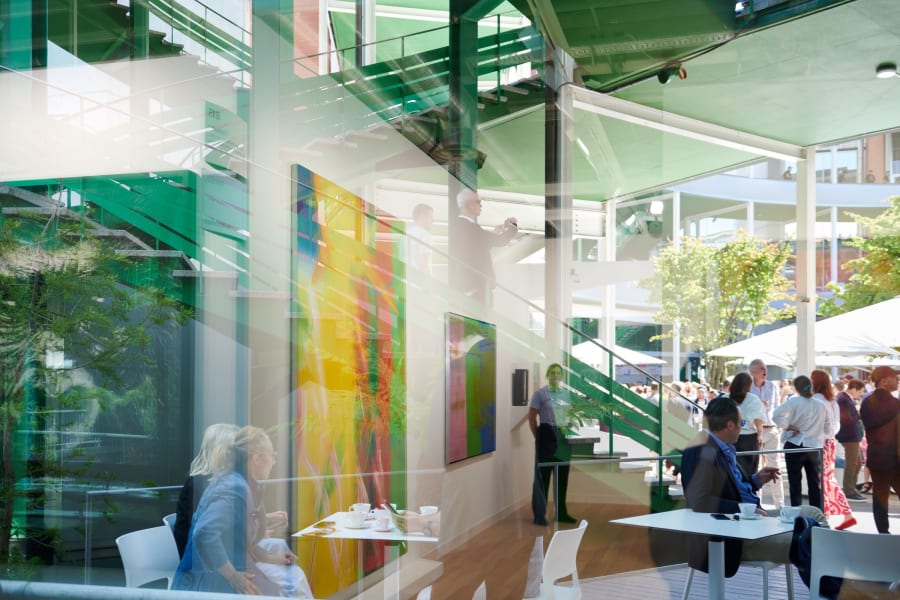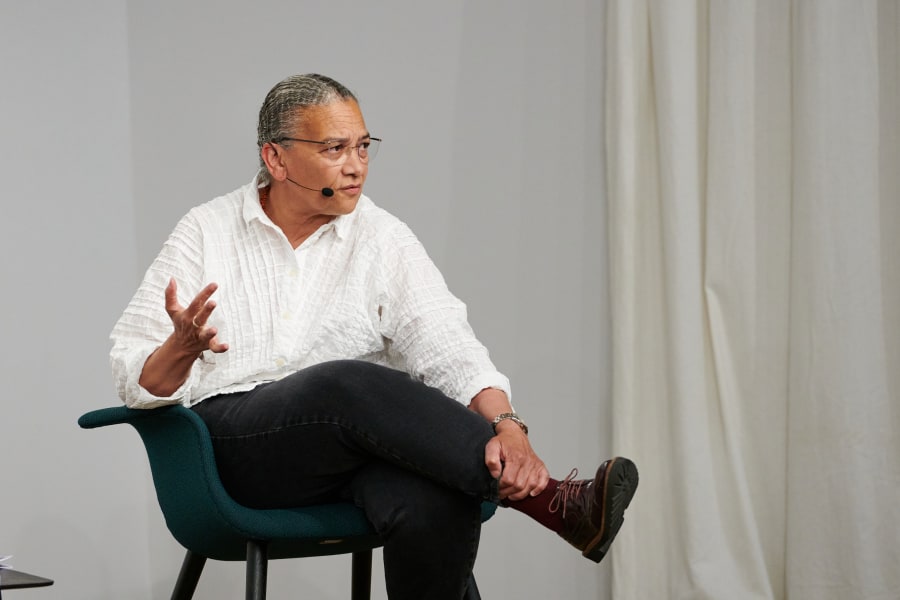Many of us have seen Keith Haring’s work before – be it in a museum, on a T-shirt, or on a coffee mug.
Not many of us, however, have had the opportunity to marvel at a 46-meter-long Haring mural, originally made for a New York highway in 1984.
For those visiting Art Basel in Basel come June, that might change: Keith Haring’s gigantic Untitled (FDR NY) #5-22 (1984) is part of this year's Unlimited sector, dedicated to large-scale and immersive projects. One could say that experiencing a work such as this one constitutes a once-in-a-lifetime opportunity.
Art Basel’s curated public programs and special sectors, such as Unlimited, are crucial to how it generates its unique energy. It might be the monumental works that provide stop-you-in-your-tracks moments, or the panel discussions, where current ideas are explored by international experts and give context to artists’ endeavors. They are part of the reason why Art Basel remains a magnet, not only for collectors, art advisors, and dealers, but museum directors, critics, curators, and of course artists and the wider public as well.
Every sector is helmed by a curator, whose vision must be freshly attuned to each edition of the fair. They bring years of expertise and specialization to the job’s unique demands, be it the technical challenge of installing a painting the length of a street, staging performance art in a busy shopping mall, or ensuring the talking heads create the right conversation starters.
At Art Basel in Basel, the company’s marquee show in Switzerland, the must-see for many visitors is Unlimited. This year, around 70 monumental works will be installed within a hall of 16,000 m2, overseen by the sector’s curator, Giovanni Carmine, the director of Kunst Halle Sankt Gallen in northeastern Switzerland. ‘It’s a huge challenge because you start from scratch and must give form to a space, where none existed before,’ he says.
To participate in Unlimited, galleries submit proposals to Art Basel’s long-standing Selection Committee, made up of gallerists. ‘We want Unlimited to be as eclectic and diverse as possible to really give an overview of what is happening in the contemporary art world now,’ reflects Carmine. It veers from outstanding historical works to new productions that vie with what big events like biennials can offer. He points out, though, that it is not only about scale. ‘A tiny piece might require huge space to untangle its force.’
This year’s selection includes an installation of Robert Frank’s iconic series ‘The Americans’ (1955-57) in its entirety: 83 black-and-white photographs capturing Beat-era American life, from diners to funerals and parades, presented by galleries Thomas Zander and Pace. There is of course the aforementioned Keith Haring painting, brought to Basel by Martos Gallery and Gladstone Gallery, and a rarely-seen work by the master of fleeting monumentality, Christo, courtesy of Gagosian. Younger voices include the Zimbabwean artist Kresiah Mukwazhi, showing work with Jan Kaps and Blank Projects.
For galleries, it is an opportunity to introduce art to top professionals, be it a unique work by a well-established name or a very young artist yet to make a mark. With no underlying theme uniting the selection of artworks, the curator faces particular challenges to put them in dialogue in a space. ‘It’s a fun and complicated puzzle,’ Carmine says. ‘The curatorial challenge is to generate productive or sometimes surprising encounters between artworks of artists from different generations and backgrounds.’
The installation takes a packed 3 weeks, beginning with the installation of lights and then walls. Finally, it is the galleries’ turn, each of which brings its own team of technicians. ‘The first time I curated Unlimited, I stood alone in the space after the install and I felt I understood what it is,’ remembers Carmine. ‘It’s a group exhibition with an urban scale. An outdoor exhibition, indoors.’
Beyond Art Basel’s exhibition hall on Messeplatz, since 2010 the fair has staged an actual outdoor public art show, Parcours, whose site-specific artworks respond to unexpected locations around the city that are free to visit. ‘It’s an invitation to visitors to get to know the city differently, and from the perspective of its various artistic projects,’ says Stefanie Hessler, the newly appointed curator of Parcours and director of the Swiss Institute in New York. Hessler is known for exhibitions addressing processes of trade, globalization, and ecology; with this in mind, her debut edition of Parcours focuses on ‘transformation and circulation.’ While recent iterations were centered on the opposite side of the Rhine, Hessler is focusing on the area around Clarastrasse, the street going to and from the fair. ‘It’s undergoing acute transformation and reflects how our behavior in urban space is changing, as humans, citizens, and consumers,’ she says.
A number of shops will incorporate art, including window displays featuring neon signs from Tschabalala Self’s ‘Bodega Run’ project, depicting everyday foods. At the African groceries store Tropical Zone, another artist to explore cultural heritage, Alvaro Barrington, is creating a display structure for goods as well as new paintings. Meanwhile, the sculptor Nina Canell is staging new video work in one of the nuclear bunkers found beneath many Swiss apartment blocks, built in the wake of World War Two. ‘During the year they have many purposes,’ says Hessler. ‘Some are used as rehearsal spaces for carnival troupes, one bunker is used by a table tennis club.’
Installing work in these varied locations means rising to some unique demands. ‘Some works are created specifically for their sites,’ says Hessler. ‘In other cases, we have to make the perfect viewing environment for an existing work.’ For Swedish artist Lap-See Lam’s video installation, which explores the cultural currents and economic pressures within Chinese restaurants, this means building a special room within the Klara food court to create the necessary immersive situation for her floor to ceiling projections.
From the moment applications for Parcours closed in January, Hessler has been in constant conversation with the selected artists, developing projects as well as negotiating the use of sites. The install itself, however, will take place in an intense 3 days with teams of technicians from galleries, artists’ studios, and Art Basel. It is a daunting process that Hessler feels curating large-scale events, such as the Canadian biennial Momenta in 2021, has prepared her for. ‘Parcours is a bit like a mini biennial or festival,’ she says. ‘There are so many teams involved and so much energy around it. It’s a very collaborative project, which I love.’
Freely accessible events organized by Art Basel must satisfy a broad audience of both specialists and art novices, something Kimberly Bradley, curator of Conversations, the fair’s talks program, is keenly aware of. ‘We program with this in mind,’ she explains. ‘The topics are very current and while you can dive into academic discussions, we also take in the bigger picture.’
Conversations is, in its curator’s words, ‘a mosaic’ without an overarching theme. Now in its 20th year, recurring panels include discussions about the art market, technology, and museums, as well as a flagship discussion with a leading contemporary artist – the Premiere Artist Talk. Each event is the product of careful planning and rooted in Bradley’s work as an art critic (Bradley is also a commissioning editor for Art Basel Stories). ‘I keep an eye on the larger arcs, narrative threads, or synergies that are happening in the art world and why are they important’ she says. ‘I also see who shines on stage, who fits with certain topics, and what personalities work together.’
To celebrate the anniversary, uber-curator Hans Ulrich Obrist will be chairing a discussion on what Bradley describes as a difficult subject in today’s climate: utopias. Given Conversations’s mission to address the contemporary landscape, Bradley also felt it was essential to tackle how current political conditions impact artmaking: ‘We’re asking artists how political situations change their production. How, and with what urgency, might they feel compelled to address certain things?’
The program will end on a lighter note: a panel addressing humor. ‘A lot of artists who incorporate humor in their work deal with difficult topics, but they hit viewers differently,’ reflects Bradley.
While Conversations is wide-ranging, Bradley must also create connective tissue for its disparate topics. ‘I’m asking each moderator to ask the same question: how do we speculate on the future?’ she says. ‘Do we want to be optimistic or pessimistic whether we’re talking about sustainability, tech or the market? What are the speakers’ predictions? We want to explore solutions we can stand behind.’
Creating a framework that allows for free digression and pre-talk Zooms between participants are essential. ‘Panels can get wonky without that prep,’ laughs Bradley. In a first, this year’s talks will be kept small, with one moderator and two speakers. ‘It’s hard to get the depth with a panel of five people,’ explains Bradley. ‘A smaller panel is so much more generative.’
As Bradley observes, sectors like Conversations add ‘symbolic value’ for visitors to a fair. ‘It can get forgotten in the flurry of the fair, but centuries of knowledge are behind the art that is sold,’ she reflects. ‘The Conversations shine a light.’
It is a sentiment applicable to all Art Basel’s special sectors, which affirm it takes more than commerce to make an art fair a truly memorable experience.


